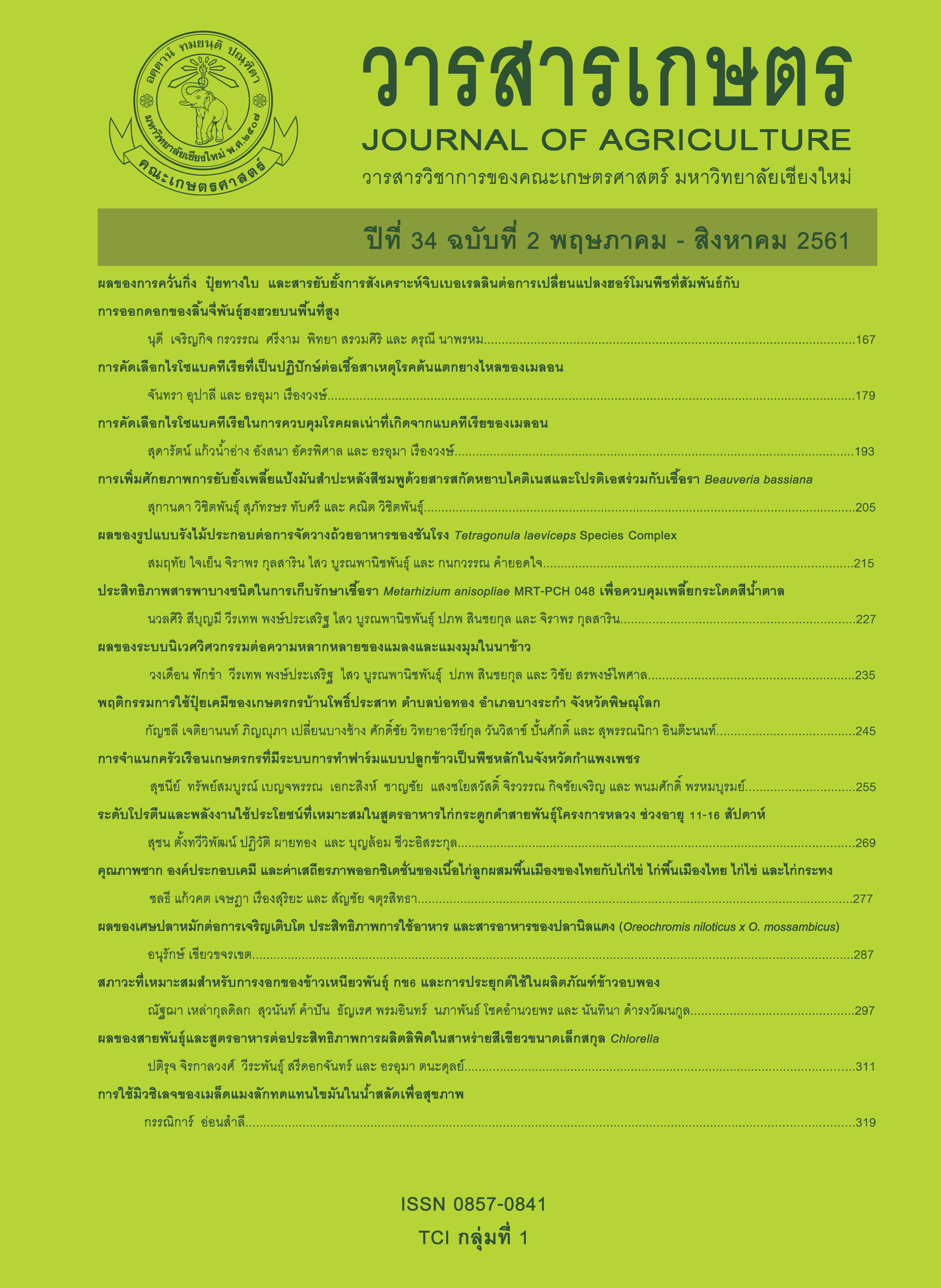ผลของสายพันธุ์และสูตรอาหารต่อประสิทธิภาพการผลิตลิพิด ในสาหร่ายสีเขียวขนาดเล็กสกุล <I>Chlorella</I>
Main Article Content
บทคัดย่อ
การทดสอบอิทธิพลของสายพันธุ์สาหร่าย สูตรอาหารเพาะเลี้ยง และปฏิสัมพันธ์ของสายพันธุ์สาหร่ายและสูตรอาหารเพาะเลี้ยงต่ออัตราการเจริญเติบโตจำเพาะ ผลผลิตชีวมวล ประสิทธิภาพการผลิตชีวมวล ปริมาณลิพิด และประสิทธิภาพการผลิตลิพิด โดยเพาะเลี้ยงสาหร่ายขนาดเล็ก 3 สายพันธุ์ คือ สายพันธุ์ 6-4, 208 และ 209 ในอาหาร 3 สูตร ได้แก่ TAP, BG11และ N8 ผลการทดลองแสดงให้เห็นว่าสายพันธุ์สาหร่ายมีผลต่อปริมาณลิพิด และประสิทธิภาพการผลิตลิพิดอย่างมีนัยสำคัญทางสถิติ โดยสาหร่ายสายพันธุ์ 6-4 ผลิตลิพิดได้สูงสุดที่ 8.33 เปอร์เซ็นต์ และมีประสิทธิภาพการผลิตลิพิด 1.39 กรัมต่อลิตรต่อวัน สูตรอาหารเพาะเลี้ยงมีผลต่อทุกตัวแปร (อัตราการเจริญเติบโตจำเพาะ ผลผลิตชีวมวล ประสิทธิภาพการผลิตชีวมวล ปริมาณลิพิด และประสิทธิภาพการผลิตลิพิด) อย่างมีนัยสำคัญทางสถิติ โดยอาหารสูตร TAP ทำให้สาหร่ายมีอัตราการเจริญเติบโต ผลผลิตชีวมวล และประสิทธิภาพการผลิตชีวมวลสูงที่สุดเท่ากับ 0.17 ต่อวัน 1.11 กรัมต่อลิตร และ 0.12 กรัมต่อลิตรต่อวัน (ตามลำดับ) อย่างไรก็ตาม ปริมาณลิพิด และประสิทธิภาพการผลิตลิพิดของสาหร่ายที่เลี้ยงด้วยอาหารสูตร TAP และ BG11 ไม่แตกต่างกันทางสถิติ ปฏิสัมพันธ์ของสายพันธุ์สาหร่ายและสูตรอาหารเพาะเลี้ยงมีผลต่ออัตราการเจริญเติบโตจำเพาะ ปริมาณลิพิด และประสิทธิภาพการผลิตลิพิดอย่างมีนัยสำคัญทางสถิติ สาหร่ายสายพันธุ์ 6-4 ที่เลี้ยงในอาหารสูตร TAP มีปริมาณลิพิดสูงที่สุดเท่ากับ 10.5 เปอร์เซ็นต์ และมีประสิทธิภาพการผลิตลิพิด 1.76 กรัมต่อลิตรต่อวัน เนื่องจากประสิทธิภาพการผลิตลิพิดเป็นปัจจัยหลักในการผลิตเชื้อเพลิงชีวภาพ ดังนั้นสาหร่ายสายพันธุ์ 6-4 ที่เลี้ยงในอาหารสูตร TAP ควรได้รับการพิจารณา
Article Details
เอกสารอ้างอิง
ผกามาศ ชิดเชื้อ ปติรุจ จิรกาลวงศ์ และ อรอุมา ตนะดุลย์. 2560. วิธีการทำให้เซลล์แตกเพื่อการสกัดน้ำมันจากสาหร่ายขนาดเล็ก. วารสารเกษตร 33(2): 185-191.
Chisti, Y. 2007. Biodiesel from microalgae. Biotechnology Advances 25(3): 294-306.
Gour, R.S., A. Kant and R.S. Chauhan. 2014. Screening of microalgae for growth and lipid accumulation properties. Journal of Algal Biomass Utilization 5(1): 38-46.
Griffiths, M.J. and S.T.L. Harrison. 2009. Lipid productivity as a key characteristic for choosing algal species for biodiesel production. Journal of Applied Phycology 21(5): 493-507.
Hamedi, S., M.A. Mahdavi and R. Gheshlaghi. 2012. Lipid content and biomass production of Chlorella vulgaris is affected by growth conditions. pp. 65-68. In: Proceeding of the Second Iranian Conference on Renewable Energy and Distributed Generation. IEEE, Tehran.
Harris, E.H. 1989. The Chlamydomonas Sourcebook: A Comprehensive Guide to Biology and Laboratory Use. Academic Press, San Diego, 780 p.
Leu, J.Y and Y.H. Lin. 2013. Optimization of nutritional compositions of growth medium for Chlorella sp. FJ3 growth kinetics in batch and continuous-flow photoreactors. Environmental Technology 34(20): 2841-2851.
Mandalam, R.K. and B.O. Palsson. 1998. Elemental balancing of biomass and medium composition enhances growth capacity in high-density Chlorella vulgaris cultures. Biotechnology and Bioengineering 59(5): 605-611.
Mata, T.M., A.A. Martins and N.S. Caetano. 2010. Microalgae for biodiesel production and other applications: a review. Renewable and Sustainable Energy Reviews 14(1): 217-232.
Miazek, K., D. Goffin, A. Richel and C. Remacle. 2014. Growth of Chlorella in the presence of organic carbon: a photobioreactor study. In: Proceeding of International Procesni Technika, Prague, Czech Republic, pp. 5-10.
Pittman, J.K., A.P. Dean and O. Osundeko. 2011. The potential of sustainable algal biofuel production using wastewater resources. Bioresource Technology 102(1): 17-25.
Sharma, A.K., P.K. Sahoo, S. Singhal and A. Patel. 2016. Impact of various media and organic carbon sources on biofuel production potential from Chlorella spp. 3 Biotech 6(2): 116. doi: 10.1007/s13205-016-0434-6.
Stanier, R.Y., R. Kunisawa, M. Mandel and G. Cohen-Bazire. 1971. Purification and properties of unicellular blue-green algae (Order Chroococcales). Bacteriological Reviews 35(2): 171-205.
Tanadul, O., J.S. van der Gheynst, D.M. Beckles, A.L.T. Powell and J.M. Labavitch. 2014. The impact of elevated CO2 concentration on the quality of algal starch as a potential biofuel feedstock. Biotechnology and Bioengineering 111(7): 1323-1331.
Wang, W., F. Han, Y. Li, Y. Wu, J. Wang, R. Pan and G. Shen. 2014. Medium screening and optimization for photoautotrophic culture of Chlorella pyrenoidosa with high lipid productivity indoors and outdoors. Bioresource Technology 170: 395-403.


